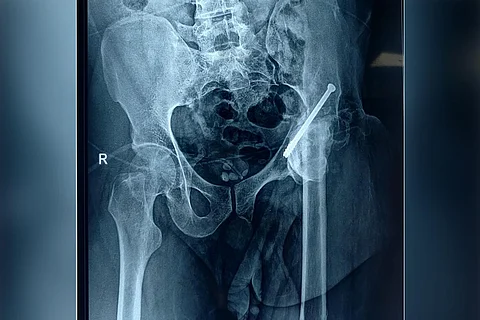

“I was suffering from depression,” says 37-year-old Kasim who is a survivor of a 2018 bomb blast in Yemen. Kasim suffered devastating leg injuries in the bomb blast and is finally able to walk independently post a complex hip reconstruction surgery conducted at Aster RV Hospital, Bengaluru. The doctors used 3D printing technology to prepare for the surgery.
Kasim became victim to the terrible bomb blast when he 33, post which he has been in and out of hospitals looking for a permanent solution. He had undergone 23 surgeries in Yemen in the last three years. As a result of the injury and consequent surgeries, he was left with a fused hip and shortened left leg.
He said, “I had to use a prosthesis for my left leg so that it would touch the ground and additionally needed crutches to walk. I could not even use a wheelchair to move around as I could not bend my hip properly to sit on it.”
Life was miserable for Kasim as nobody was willing to give him a permanent job due to his disability. Doing simple things such as cooking, cleaning, bathing and even just sitting became a huge task for him. His fused hip made it impossible for him to have a full range of movements in his leg, leading to urogenital health complications as he was unable to bend properly to maintain personal hygiene.
Kasim was referred to Aster RV Hospital, JP Nagar, Bengaluru by his friend. After a thorough evaluation and understanding of his requirements and the gravity of his injuries, the doctors at the hospital decided to carry out an advanced surgery. Accordingly, a complex primary hip reconstruction surgery was conducted on February 2 using specialized hip implants since there was extensive damage to his hip.
The doctors used 3D printing technology to get a three-dimensional view of the injured area. 3D printing allows the surgeon to get a physical 3D model of the desired patient anatomy that could be used to accurately plan the surgical approach along with cross-sectional imaging or modelling custom prosthetics.
Eventually, the technology helped the doctors map out the best way to approach the damaged area. “Kasim had lost the entire ball and socket of his hip and the remnant was fixed to his hip due to which no movement was possible. The repeated surgeries and loss of soft tissue changes the normal anatomy which made the surgery more difficult,” explained Dr JV Srinivas, Lead Consultant – Orthopedics, Aster RV Hospital.
The surgery was conducted over a period of four hours. Post successful surgery, Kasim underwent rehabilitation as well. According to an official statement from the hospital, his hip is now stable and can be moved around freely, returning him to his previous independence. He now finds it easy to carry out most of his daily activities. Having removed his stitches, he is now undergoing rehabilitation and plans to leave for his country soon.